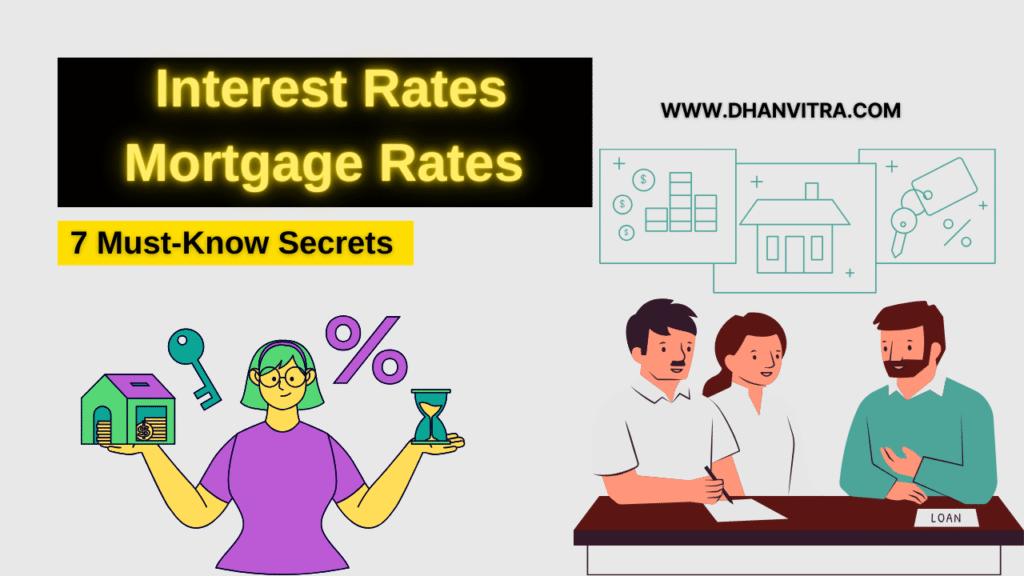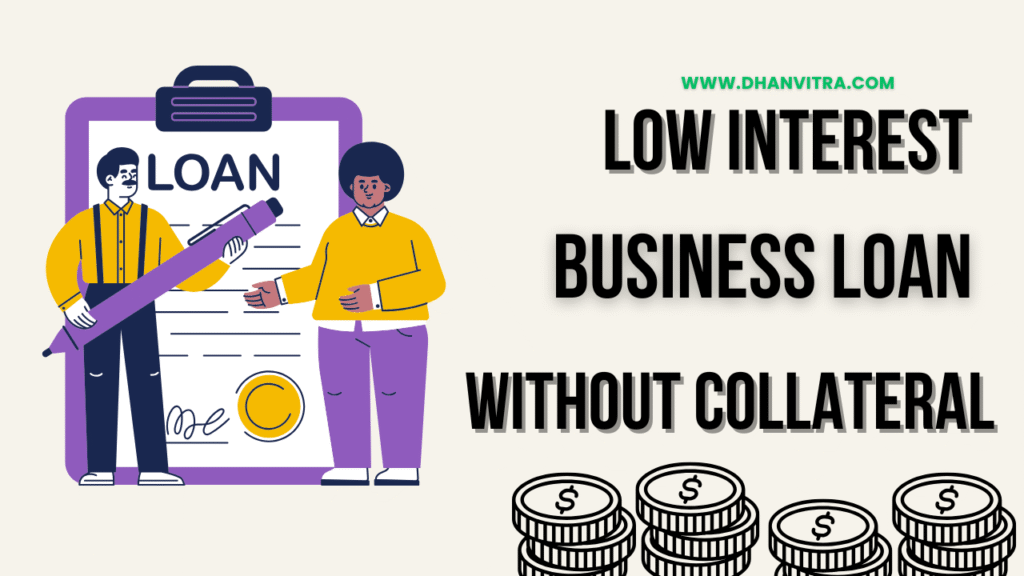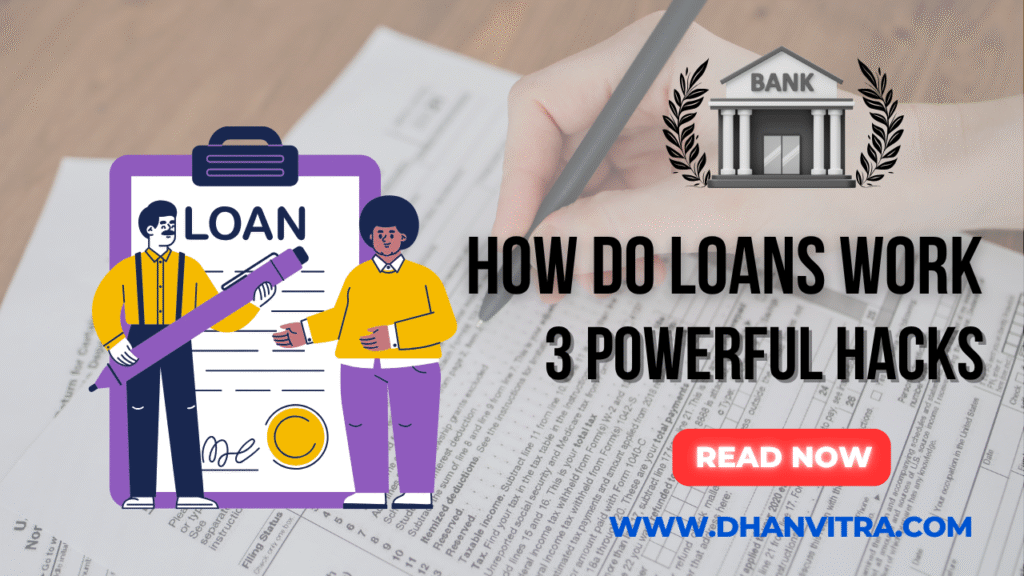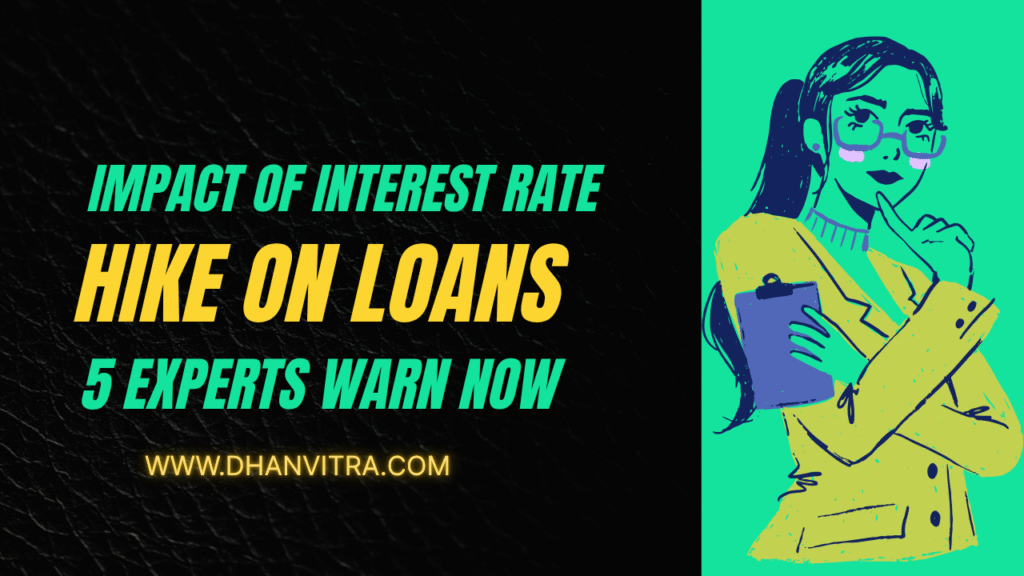
At Dhanvitra, we believe money decisions should be empowering, not overwhelming. Whether it’s about investing, saving, or borrowing smartly—we break down complex topics into easy-to-understand guides that help you take charge of your financial future.
When it comes to buying a home, one of the most critical factors you’ll face is your Interest Rates Mortgage Rates. It’s not just a number—it’s the hidden lever that decides how affordable your dream home really is. A slight change in rates can mean the difference between manageable monthly payments and long-term financial stress.
In this article, we’ll uncover 7 must-know secrets about mortgage interest rates—insights that can help you save money, avoid common pitfalls, and make smarter choices while navigating the home loan process. If you’ve ever wondered why rates fluctuate, how your credit score plays a role, or what lenders don’t always tell you, you’re in the right place.
Table of Contents
Secret 1 – The Credit Score Connection
One of the best ways to work out what kind of mortgage you’re getting is by checking your credit score. Consider it to be your financial reputation; the better it is, the more trustworthy you appear to lenders. Globally, whether you are in the United States, the United Kingdom, Canada, India, or Australia, the principle remains the same: a better credit score often means a lower interest rate.
The reason this is important is as follows. Is it worth considering a 30-year mortgage for acquiring an apartment on a speculative basis? The difference between a 5% rate due to a good credit score and a 6% rate due to a lower one is contingent on whether you are eligible for the 5% rate because of your excellent credit rating. perhaps thousands of dollars during the course of the loan. In conclusion, your credit score is not merely a statistic; it is a financial instrument that has the power to sway the balance in your favor or against you.
Improving your score before applying is like training before a big race. Paying bills on time, reducing existing debt, and checking for errors in your credit report are strategies that work across markets. Lenders see consistency as stability, and stability translates into lower risk—and lower risk for them means better interest rates for you.
Secret 2 – Fixed vs Adjustable Mortgage Rates
One of the first decisions you’ll face when choosing a mortgage is whether to go for a fixed or adjustable rate.
A fixed mortgage rate is like signing a long-term peace treaty with your lender. Your rate won’t change, your monthly payment remains predictable, and you can plan your finances with confidence. This option is especially useful if you’re planning to stay put for a decade or longer, or if you simply don’t want to gamble with market fluctuations.
On the other hand, adjustable mortgage rates (also called ARMs in the U.S. or variable-rate mortgages in other parts of the world) start lower than fixed rates. But here’s the catch: after an initial period, the rate adjusts based on market conditions. If interest rates rise globally due to inflation, central bank decisions, or economic instability, your monthly payments could increase sharply.
The key to choosing wisely is self-awareness. If you’re certain you’ll move within a few years, an adjustable rate may save you money. But if you’re buying your “forever home,” the stability of a fixed rate is usually the safer bet.
Secret 3 – The Power of Loan Term Length
Loan term length is often overlooked, but it plays a massive role in how much you pay over time. When you hear someone talk about a 15-year mortgage versus a 30-year mortgage, they aren’t just talking about time—they’re talking about how much interest you’ll fork out.
For many global buyers, this option feels more affordable upfront. But there’s a trade-off: you’ll end up paying far more in interest because the lender has more time to collect from you.
By contrast, a 15-year mortgage packs more punch into each monthly payment. The installments are higher, but the interest rates are often lower, and you’ll finish your loan in half the time. It’s like choosing between a marathon and a sprint—both get you to the finish line, but in very different ways.
Globally, homebuyers need to think carefully about cash flow. If your income allows you to handle the heavier payments of a shorter term, you’ll save significantly. But if you need breathing space in your budget, stretching out to a 30-year mortgage can offer flexibility even if it costs more overall.
Secret 4 – Timing the Market
Timing really is everything when it comes to mortgages. Mortgage rates don’t sit still; they rise and fall depending on global economic conditions, inflation rates, and decisions made by central banks like the U.S. Federal Reserve, the European Central Bank, or the Reserve Bank of India.
Even a difference of half a percent in your mortgage rate can change your monthly payments substantially. That’s why locking in a rate at the right moment is so critical. For example, many lenders allow you to “lock in” your rate during the application process, protecting you from sudden market swings.
There’s also a seasonal element. In many countries, spring and summer are the busiest home-buying seasons, which sometimes pushes rates slightly higher due to demand. On the other hand, applying in slower months like late fall or winter could work in your favor if lenders are competing for fewer buyers.
But being aware of economic news, inflation reports, and central bank announcements can give you an edge. In essence, mortgage rates move like the tides—they may rise or fall unexpectedly, but understanding the rhythm can help you step in at the right time.
Secret 5 – Down Payments and Their Hidden Influence
When people talk about down payments, the number “20%” usually pops up. This figure has become a global benchmark, but it’s not always necessary, and in many cases, buyers purchase homes with less. Still, the size of your down payment does influence your mortgage interest rate in ways you might not realize.
If you’re putting 20% or more into the home upfront, you’ve already proven commitment and financial stability. In return, lenders are often willing to reward you with lower interest rates. With a smaller down payment—say 5% or 10%—you may face higher rates because the lender carries more risk.
Another hidden factor is mortgage insurance. In some markets, like the U.S., if your down payment is below 20%, you’ll likely need private mortgage insurance (PMI). This extra cost doesn’t lower your interest rate, but it does increase your overall monthly payment. In countries like Canada, mortgage default insurance works similarly.
The real secret is that down payments give you leverage. Even if you can’t hit the 20% mark, increasing your down payment by just a few percentage points can lower your interest rate, reduce your insurance costs, and save you thousands over the life of your loan. It’s one of those areas where stretching a little today can lead to significant savings tomorrow.
Secret 6 – Lender Shopping is a Must
Here’s the thing most people don’t realize: mortgage rates are not universal. The rate you’re offered can differ dramatically depending on the lender. Banks, credit unions, and online lenders all calculate risk differently, and each one has its own profit margins and promotional offers.
For example, one bank might quote you a 6.5% rate while another—on the same day, for the same borrower—offers 6.2%. That tiny 0.3% difference could save you tens of thousands of dollars over the life of your mortgage. That’s why treating the first quote you receive as gospel is a mistake.
Another factor? Some lenders specialize in certain borrower types. If you’re self-employed, you might struggle with traditional banks, but a lender experienced in non-traditional income verification could give you a better deal.
And let’s not forget negotiations. Lenders compete for your business, and sometimes simply showing them a competitor’s offer is enough to get them to lower their rate or reduce fees. Think of it like shopping for a car—you wouldn’t walk into the first dealership, pay sticker price, and drive off without comparing options. Your mortgage deserves the same level of scrutiny—only the stakes are far higher.
Secret 7 – Government Programs and Hidden Perks
Governments around the world recognize that homeownership drives economic stability. That’s why they often provide special mortgage programs with reduced interest rates, flexible terms, or lower down payment requirements.
In the United States, programs like FHA loans cater to first-time buyers with smaller down payments, while VA loans offer military veterans zero-down options and excellent rates. In countries like Canada, government-backed mortgage insurance helps reduce lender risk, allowing borrowers to secure competitive rates even without a massive down payment. Meanwhile, in the UK, “Help to Buy” schemes provide equity loans for new builds, lowering upfront costs for buyers.
But here’s the catch: these programs often fly under the radar. Many buyers never even hear about them unless they dig deep or talk to a savvy broker. That’s why research is your best weapon. Ask lenders directly about government-backed programs. Sometimes, simply qualifying for one can mean shaving half a percentage point—or more—off your interest rate. Over time, that’s not just pocket change; it’s life-changing money you could reinvest in your home or future.
Extra Insights on Mortgage Rates
Mortgage rates don’t exist in a vacuum. They’re shaped by global and local economic forces, many of which buyers overlook.
Inflation is one of the biggest players. When inflation rises, central banks often increase interest rates to keep spending under control. On the flip side, when economies slow down, central banks may cut rates to encourage borrowing and investment—great news for anyone shopping for a mortgage.
The decisions of financial giants like the U.S. The Federal Reserve, the European Central Bank, and the Bank of England all have an impact on the rest of the world. Even if you live halfway across the globe, a single Fed rate hike can raise mortgage rates in your country if your economy is closely tied to the U.S. dollar.
And let’s not ignore global events. Think pandemics, wars, or supply chain disruptions. Each can shake investor confidence, pushing them toward safer investments like government bonds. When bond yields move, mortgage rates usually follow. That’s why your rate today could look very different a month from now—even if your personal finances stay the same.
Understanding these forces won’t make you a fortune-teller, but it will make you a smarter borrower. If you can see the big picture, you’ll know when to lock in a rate—or when to wait it out.
Common Mistakes Homebuyers Make
Even the most prepared buyers fall into traps when it comes to mortgage rates. One of the most common mistakes is underestimating the power of small changes. A quarter-point increase might sound harmless, but over 25 or 30 years, it can add up to tens of thousands in extra interest. People often focus on negotiating home prices while ignoring the silent cost of a slightly higher mortgage rate.
Another pitfall is overlooking closing costs and hidden fees. A lender may dazzle you with a low interest rate, but if the loan comes with sky-high origination fees, appraisal costs, or penalties, you could end up paying more in the long run. Always read the fine print and compare the full annual percentage rate (APR), not just the headline interest rate.
Then there’s the timing issue. Many buyers wait until the last possible moment to apply for a mortgage, assuming their finances are good enough. But lenders look at the bigger picture—your debt-to-income ratio, your job history, and even your spending habits. Preparing six months ahead of time by cleaning up your credit and lowering debts can make a dramatic difference in the rate you’re offered.
Finally, too many buyers skip pre-approval. Without it, you lose bargaining power. Sellers and agents take you less seriously, and you may miss out on locking in favorable rates early. In fast-moving markets, this mistake can cost you both the house and the deal.
Practical Tips to Secure the Best Rate
Securing the lowest possible mortgage rate is less about luck and more about preparation. The process starts months before you even sit down with a lender. Think of it as training for a marathon—your financial health has to be in shape long before race day.
The first step is organizing your finances. If your bank statements show irregular spending or multiple debts, you may appear risky in their eyes. By reducing unnecessary expenses and paying down high-interest debt, you create a clean financial profile that tells lenders you’re reliable.
Another crucial move is improving your creditworthiness. This doesn’t happen overnight, but small steps—like keeping your credit card balances low and ensuring all bills are paid on time—can bump up your score quickly. Some borrowers even delay applying for a mortgage by six months to give themselves time to polish their credit reports. That patience often pays off in the form of a noticeably lower rate.
Timing also matters more than many realize. That’s why many buyers choose to “lock in” their rates once they see an attractive number. Rate locks usually last from 30 to 60 days, giving you time to close without worrying about sudden hikes.
Lastly, don’t underestimate the power of pre-approval. It doesn’t just show sellers that you’re a serious buyer; it also gives you leverage when negotiating with lenders. A pre-approved borrower is more likely to receive competitive offers, simply because lenders see less uncertainty in the deal.
Conclusion – Interest Rates Mortgage Rates
Mortgage interest rates can feel like a complicated puzzle, but the truth is, once you know the secrets, the picture becomes much clearer. The rate you get is significantly impacted by your credit score, the kind of loan you select, the time you apply, and even the way you deal with lenders.
The difference between a good rate and a bad one isn’t just a few dollars—it could add up to tens of thousands over the life of a loan. That’s money that could otherwise go toward investments, education, or building the life you dream of.
So, approach your mortgage like a savvy shopper. Prepare your finances, stay informed about market shifts, and never be afraid to ask questions or explore multiple options. With the right strategy, you’re not just buying a home—you’re also securing your financial future.
FAQs
What is the average mortgage rate right now?
Mortgage rates vary depending on the country, lender, and economic climate. Generally, global averages range between 5% and 7% for 30-year fixed loans, but these figures can fluctuate. Always check current market conditions before applying.
Can I refinance to get a lower rate later?
Yes, refinancing allows you to replace your existing loan with a new one at a potentially lower rate. Many homeowners refinance when interest rates drop or when their credit scores improve, reducing monthly payments and long-term interest costs.
Does debt-to-income ratio matter?
One of the best ways to work out what kind of mortgage you’re getting is by checking your credit score. Have the option of securing a 30-year mortgage for ten years on redeemed Your ability to pay your mortgage with ease is indicated by a lower DTI, which may help you get better rates.
How long does a mortgage pre-approval last?
Most pre-approvals remain valid for 60 to 90 days. If you don’t find a home within that time frame, you may need to update your documents and reapply. The good news is that updating usually takes less effort than the first application.
Should I lock in a rate or float it?
Securing a rate safeguards you against unexpected increases, which is prudent if rates appear to be on the rise. Choosing to float can be beneficial if you anticipate that rates will decrease, although it does involve some risk. The most secure choice for many purchasers is to agree to the terms once they feel satisfied with the proposal.











This article is a must-read for anyone considering a mortgage! The advice on comparing lenders was particularly useful—I’ll be using that for my next steps
Fantastic content! The section on how credit scores impact mortgage rates was super informative. I’m definitely going to keep these tips in mind as I plan my home purchase!
These secrets about mortgage rates are game-changers! I had no idea how much timing could affect my interest rate. Thanks for breaking it down so clearly!
Great insights on mortgage rates! I always thought they were pretty straightforward, but these secrets really opened my eyes to the nuances involved. Appreciate the info!
Wow, I learned so much from this! The tips on locking in rates and understanding points were especially helpful. Definitely sharing this with my friends who are looking to buy!